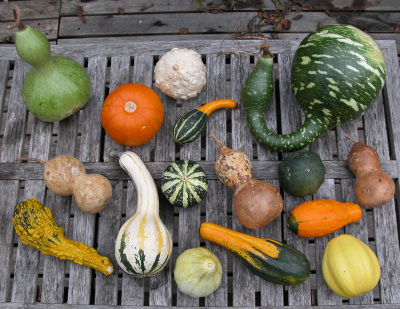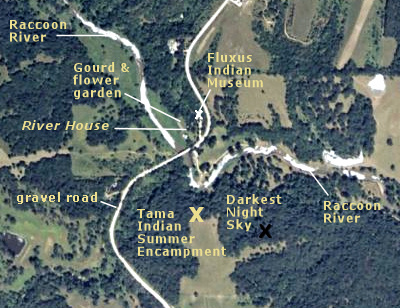
Every summer for more than fifteen summers my childhood friend, Liz Garst, has grown decorative gourds in her garden. Liz lives several miles south of Coon Rapids, Iowa, in an area known as the Whiterock Conservancy. Her garden is near the banks of the Raccoon River and about 200 feet west and downhill from the Fluxus Indian Museum (Liz has housed the FIM in guest quarters above her large truck and tractor garage since 1994). Every fall she harvests a large crop of gourds, and distributes them to friends far and wide. Some of us get ours by mail in a cardboard box--wrapped in pages from The Des Moines Register. The latest installment of this tradition just arrived...unwrapped here for your viewing pleasure.
The garden where these gourds were grown is just across the river from a bluff of white sandstone rocks. Small groups of Meskawki (or Fox?) Indians used to come--by car--and spend part of their summers on top of this bluff gathering herbs and fishing--up until as late as the 1940s. This site is also part of an area that astronomers have identified as being one of the "darkest" sky spots in the midwest part of the United States (far away from cities and lights, minimal cloud cover). I have never seen so many stars in the night sky as you can see when standing in a clearing here on a winter night.

Liz and I grew up in the 1950s & 60s (graduating from high school in 1969). When we were children American popular kids' culture was going through a phase of romanticizing the American Indians of the past. American Indians were portrayed in "westerns" and other TV shows, comics, and other forms of popular culture as having "been" interesting and generally good people who on occasion would support and assist the "white man" (my favorite: Tonto--the Lone Ranger's Indian assistant). We were also taught that the Indians knew how to live off the land and had learned many valuable natural skills (like making moccasin shoes)...so their spirit and imagery were often evoked by Boy and Girl Scout groups, too. Playing with bows and arrows, wearing headdresses, Indian beaded belts, and Indian patterned blankets were "cool." It was still better to play being a cowboy (the "winners"), but the Indians could be "cool," too. This period was one of the last and odder phases of American culture destroying/suppressing/neutralizing American Indian culture by creating and assimilating cartoon versions of it into its own culture. A lot of this stuff got re-re-assimilated when this boomer generation grew up and became hippies -- leather fringe coats, wearing moccasins (with rubber soles), smoking marijuana in peace pipes, communes and getting "back to the land."
The original immigrants to America became fearful of American Indians and there were many incidents of violence between immigrant and Indian groups (also many incidents of cooperation and mutual help). But fear--and the diseases the immigrants brought with them--won out. The growing immigrant population and their descendants "solved" their Indian problem militarily and culturally. Armed Indians were defeated and the rest relocated to various reservations. On these reservations, the government and religious supervisors tried to re-educate them so they could become part of the dominant culture. By the time Liz and I were born, the once real-life reports about the "savage" "scalping" "murderous" Indians had faded into stories from the distant past. Now that the Indian people were no longer a military or cultural threat, American culture was free to romanticize and embrace the "interesting," often noble and "spiritual" people who had lived here before we arrived (and ignore or pity their "drunken" impoverished descendants). It is as if the last step in putting a competing race/culture behind you is to assimilate it and distort it and dress it up in ways that now makes it palatable and non-threatening to the dominant culture. Culture's way of assuaging its own guilt...its attempt to wash its own bad taste out of its own mouth...done with popular culture, children and hippies.
1 comment:
I too have been a gourd farmer since about 1986 or so. While we lived in Madison I built 4'x4' boxes & drove in soil from miles away. After we got to Dreamtime we've had unlimited space to grow, but usually each year I only grow a couple varieties. This year I grew canteen & extra warty gourds. Here's a gourd site that we've created in the past:
All Gourds
And here's a bunch of samples from an audiowork called Gourdaphonia. All the instruments are from gourds we grew.
gourd samples
Post a Comment